| |
| Jaipur was and remains the only city in the world, symbolising the nine divisions of the universe, through nine rectangular sectors sub-dividing it. |
| |
The Rose Pink City founded by Maharaja Jai Singh II (1693-1743), is the capital of Rajasthan. The Old City (Known as the Pink City) is a great place to wander around. The whole city was painted in Pink colour by Maharaja Man Singh II when Prince of Wales, later Edward VII, visited Jaipur in 1876 AD. Today, every home within the city is obliged by law to maintain its facade. It is a very well planned city laid out in a grid pattern and was designed by a young Bengali engineer and scholar by the name "Vidyadhar Bhattacharya". The city is located at a distance of around 258 km from Delhi and 232 km from Agra. Jaipur got its name from its founder Sawai Jai Singh (1693-1743), who had the vision to create a meticulously planned city as his capital. Jaipur was and remains the only city in the world, symbolising the nine divisions of the universe, through nine rectangular sectors sub-dividing it. Jaipur is a royal city & this is its most noticeable aspect, small buildings & festivals testify it. Jaipur & its surroundings are rather like an endless museum. The city also offers an endless variety of crafts. Jewellers here still fashion the beautiful enamel-on-gold pendants, studded on the reverse with precious stones or pearls & turquoise that one sees in miniature paintings. Jaipur's lacquer bangles are famous all over the world. This is a city to be visited. The Pink City Jaipur, Capital of Rajasthan, is famous for its blue pottery semi-precious stones & Handicrafts. |
| |
| How to Reach |
 |
 |
 |
By Air:
Jaipur has its own airport, and is well connected to all other tourist and business centers. |
By Train:
An excellent connection to Delhi by Shatabdi Express and the Pink City Express. Other connections to Jaipur are from Bikaner, Jodhpur, Udaipur, Ahemadabad, Secunderabad and Lucknow. |
By Road:
A network of reasonably comfortable tourist buses, run by road corporations of Rajasthan, Haryana and others. |
|
| |
| Places of Interest |
| |
- Museums
- Forts
- Temples
- Monuments
- Gardens
| |
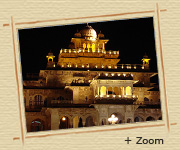 Central Museum Central Museum
Located in the Ram Niwas Garden, the Central Museum or Albert Hall is a mixture of pillars, arches, and courtyards adorned with murals. There is a huge collection of objects displaying different facets of Rajasthani culture and history. There are miniature paintings, ivory carvings, costumed mannequins, and shields depicting scenes from the Hindu epics, among others.
|
| |
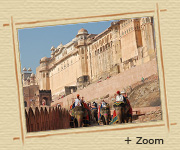 Amer (Jaipur) Archaeological Museum Amer (Jaipur) Archaeological Museum
Located in the Dil-e-Aaram Gardens, of Amer, this ancient capital of Jaipur was established in 1949. Prior to this, the excavated material from Rairh, Bairat, Sambhar, Nagar etc. and the sculptures and epigraphs collected from various sites in the erstwhile Jaipur State were housed at Vidyadhar Gardens in Purana Chat. In July 1949, the entire collection was transferred to Dil-e-Aaram Garden, a part of the old palace at Amer. An Art Gallery was inaugurated in 1992 in this complex.The museum is divided into three sections.
|
| |
| |
 Bairat Virat Nagar Museum Bairat Virat Nagar Museum
In the epic period, the area around the district of Jaipur, Alwar and Bharatpur came to be known as Matsayadesh with Virat Nagar as its capital. The museum, although not very large has the richest collection. The excavated material like potteries, pikkins, old coins, seals, metallic pieces, weapons and statues are exhibited here.
|
| |
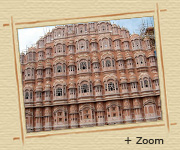 Hawa Mahal Museum Hawa Mahal Museum
Just behind the beautiful Hawa Mahal(Palace of Winds) in the adjoining Partap Mandir, a museum was set up in the year 1983. Preserved here is the sculptural heritage collected from Ganeshwar, Virat Nagar, Raid, Sambhar and Nagar.
|
| |
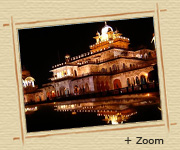 Maharaja Sawai Man Singh ji Museum Maharaja Sawai Man Singh ji Museum
Located within the City palace complex and nested amidst old buildings, temples and the palace quarters, this museum was founded in 1959 by Maharaja Sawai Man Singh II. It exhibits ancestral collections built up by the successive rulers of Amer and Jaipur
|
| |
| |
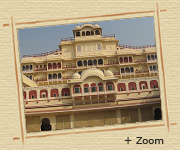 The City Palace The City Palace
The City Palace is now converted into a museum, except a small portion that is still used by the royal family of Jaipur. Built in the fortified campus style, the palace covers almost one-seventh part of the city. One of the major attractions in the museum is the portion that is devoted to the arms and ammunition used by the royal family in the past. Other important attractions are the Textile and Costume Museum, Art Gallery, Chandra Mahal, Mubarak Mahal, and Diwan-i-Khas and Diwan-i-Am.
|
| |
 Hawa Mahal Hawa Mahal
Strange though it may seem, this most famous landmark of Jaipur is not actually a palace but a series of sandstone screens. Jaipur signature building, the Hawa Mahal, a multi layered palace, was built by Sawai Pratap Singh (grand son of Sawai Jai Singh and son of Sawai Madhoo Singh) in 1799 AD and Mr. Lal Chand Usta was the architect. Famous for it's beehive like structure, the Hawa Mahal is an interplay of red and pink sand stone, carefully and painstakingly outlined with white borders and motifs.This pink structure was constructed so that the ladies of the palace could watch the royal processions without being seen by any outsider. This sandstone edifice was named Palace of Winds after the many brass wind vanes that adorned it until 1960s.
|
| |
 Amber Fort Amber Fort
Standing tall over a small hillock overlooking the Pink City, Amber is the classic romantic Rajasthan fort-palace. Amber today is nothing but a reflection of the glorious past of the fierce Kachwaha Dynasty that ruled over this region from 12th to 18th century. Man Singh I started the construction of this fort in 1592 and, perhaps, it was the defence that topped his priorities before constructing this fort. The rugged walls of this fort may not look beautiful from outside, but the interior is a virtual paradise and painted scenes of hunting and wars adorn the walls along with precious stones and mirrors set into the plaster. Half the fun at Amber Fort is the walk from the road to the fort with majestic views of the surrounding valley. An elephant ride up to the fort is also an unforgettable experience.
|
| |
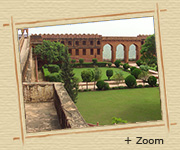 Jaigarh Fort Jaigarh Fort
Situated in the north of Jaipur, the Jaigarh Fort is structurally similar to the Amber Fort. The only exception is that it houses the mighty Jaivana, the largest wheeled canon in the world. Other attractions in the Jaigarh Fort include three water tanks, a museum, and breathtaking views of the city below.
|
| |
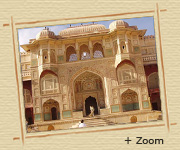 Amer Palace Amer Palace
Overlooking the Delhi Jaipur Highway, the image of the Amber Fort is beautifully reflected in the lake below. Within the Amer Fort lies the famous Jai Mandir (Temple) with its world renowned Sheesh Mahal, a hall full of Mirrors. The walls and the ceiling of the Mahal are covered with a beautiful array of mirrors, which reflect any streak of light, so as to illuminate the entire room. Located 9 Kms north west of Jaipur, the Amber Fort was once the Capital of the Minas.
|
| |
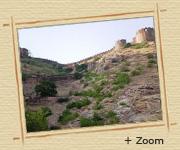 Nahargarh Fort Nahargarh Fort
Originally called Sudarshan Garh, it affords a splendid view of Jaipur.
|
| |
| |
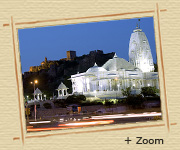 Birla Mandir Birla Mandir
Also known as the Laxmi Narayan Mandir, the Birla Mandir, situated in the south of Jaipur, has been built by wealthy Birla family, one of the largest industrial dynasties in India. This white-marble structure has three domes, each styled according to different approaches to religion.
|
| |
| |
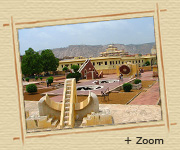 Jantar Mantar Jantar Mantar
The amazing astronomical three-storey-high observatory, of an 18th century Rajasthani king, named Jai Singh. It is located at the entrance to the city palace of Jaipur. Before constructing this observatory, he sent his emissaries to all corners to the world, who returned with many manuals of cutting-edge technology including a copy of La Hire's Tables. He built the structures following every details given in the manual, but at the end, he found to his astonishment that the observatory was 20 seconds more accurate than that given by La Hire. The observatory has 18 large instruments, many of them still in working condition.
|
| |
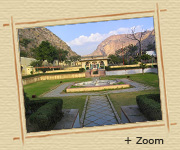 Sisodia Rani Ka Bagh Sisodia Rani Ka Bagh
The terraced Sisodia Rani Ka Bagh (the Garden of Sisodia Queen) is situated on the Jaipur-Agra road at a distance of 6 km from Jaipur. The garden was created by the queen of Jai Singh II as an escape from the court intrigues. The landscaped gardens and murals of the life of Lord Krishna, decorating its interiors, are breathtakingly beautiful.
|
| |
|
|




